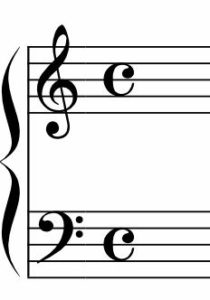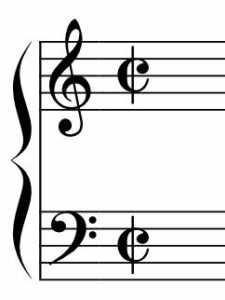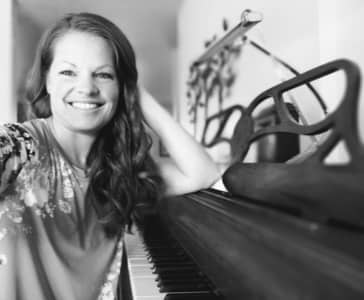You may have pulled out some music, only to find a weird line through the middle of a large C right at the beginning where the time signature sits.
What does a C with a line through it mean in music? In music, a C with a line through it is most often called “cut time” or “split time”, or alla breve. It is a 2/2 time signature. A “C” without a line through it is a 4/4 time signature and is most often called “common time”.
What does “cut time” and “common time” mean and why it is represented with a “C”?
Common Time

The symbol C has roots from long ago when music was first being notated. I did a quick search on the internet and found that the history of this is a little complex and you get slightly different answers about the real history behind it.
From what I could surmise, centuries ago, music was more often written in beats of 3, possibly to represent a religious symbolism (of the Godhead, or the trinity).
The C may have actually begun as a circle which represented the Godhead. When it was cut in half, then it could have represented the cut time.
What it used to mean has evolved into what it means now and with what musicians refer to it as common time and cut time.
So although “common time” may not be the technical or “real” meaning of this term, when we see it now, we call it that. Perhaps that’s because when we see it, we immediately associate it with the 4/4 time signature which is a time signature most of us see as “common”.
The 4/4 time signature is likely the most seen time signature in music and one we become very familiar with. With our modern culture, it is also a time signature that is easier to identify by ear because we hear it so often.
An example of a common time signature, or a 4/4 time signature, would be to have four quarter notes per measure.
Cut Time, Split Time, or Alla Breve

Once again, just like common time, history shows that cut time meant something different than what is generally accepted now for the term. When you see the C with a line through it now, it is often referred to as cut common time and represents a 2/2 time signature.
Because the 4/4 or C represents the common time, the cut time is 2/2. Generally, a 2/2 time signature is played faster than a 4/4 time signature. It has a two beat to it.
Cut common time is not as often seen as common time, but it is still used often enough to become familiar with most musicians.
We don’t often see either symbols being used in modern music. So you will notice that most often, if you are seeing common time or cut common time, it is often from classical music written years and years ago.
An example of a 2/2 time signature would be 2 half notes per measure.
Other Things to Know About Time Signatures
The time signature is written at the beginning of the piece of music. You will know immediately what the song’s rhythm and beats will be in the song as you look at the time signature.
A time signature also has an important role of letting you know what values each note will have.
in general, different time signatures can create a different style of music, or beat to it.
For example, a 3/4 time signature is often used as a waltz. It is a distinct beat to it that can be used for that 1-2-3 rhythm needed in the waltz.
A 2/2 time signature is often used as a march. The half note gets 1 count and thus, it becomes more rhythmic and steady of a beat. In general, a lot of marches are written in this time signature for that reason.
A 4/4 time signature is such a common time signature because of its versatility. It can be used for most styles of music and is a great time signature for music with singing to it.
They style and beat of the songs are largely influenced by the time signature.
How to Read a Time Signature
A time signature is written like a fraction. The top note tells you how many beats to expect per measure. It is most often a 2, 3, or a 4.
The bottom number of the time signature will determine what notes gets what count.
- A 4 at the bottom of the time signature shows that a quarter note gets one count.
- A 2 at the bottom of a time signature shows that a half note gets 1 count.
- An 8 at the bottom of the time signature shows that an eighth note gets 1 count.
There are other time signatures, but they are not as common and you likely won’t run into those in most of your music.
Time Signatures and Tempo
When you are using time signatures, it goes hand-in-hand with the tempo of the song. So, you will want to take note of the tempo in addition to paying attention to the time signature.
While the time signature tells you how many beats per measure, the tempo tells you just how fast or slow to play it! So, if you have a tempo of about 60 BPM (beats per minute), and a 4/4 time signature, then you will count one for each quarter note per beat.
For example, four quarter notes in a measure would be counted 1, 2, 3, 4 right along to the beat.
If you have a tempo of 60 BPM with a 2/2 time signature, then you will count each half note per beat. So, if you have 2 half notes in measure, each of those half notes will receive one count.
So, if you happen to have the same song with the same tempo, but not the same time signature, then a 2/2 song would be played twice as fast as 4/4 song.
Thus, if you have the same tempo of 60 BPM, the time signature will largely affect the song and how you play depending on what it is! Determining which notes get what counts will have a large impact on the timing of the song!
Just for your information, a time signature is mostly used for annotating the music, while tempo is used for how quickly to play that music.
Interested in Playing Piano?
Combining all that I have learned in teaching piano on and off for the past 17 years, I have created my very own, all virtual Learn with Pianotels program that is proving to be phenomenal for students. With a self-paced step-by-step course, the latest technology, and video chats available at any time, students are not only having a blast learning piano, they are also learning piano 8-10x faster than traditional lessons. I can’t be more excited about this program and the results I am seeing!
Just because it is tailored for kids, don’t let that hold you back from trying it out yourself. Adults have benefited just as much from kids in this course! So even though it is advertised for kids, give it a go. Learn with Pianotels is affordable for the whole family!
Tel loves her life as a piano player, a piano teacher, and a mom. Amid piano blogging, piano teaching, and piano playing, she loves a chance to fit in a good exercise class, volunteer at her kids’ school and at her church, and go on long dates with her husband. Full bio at About Tel.



Wonderful & clear explanation .
Thank you for putting this together!!!